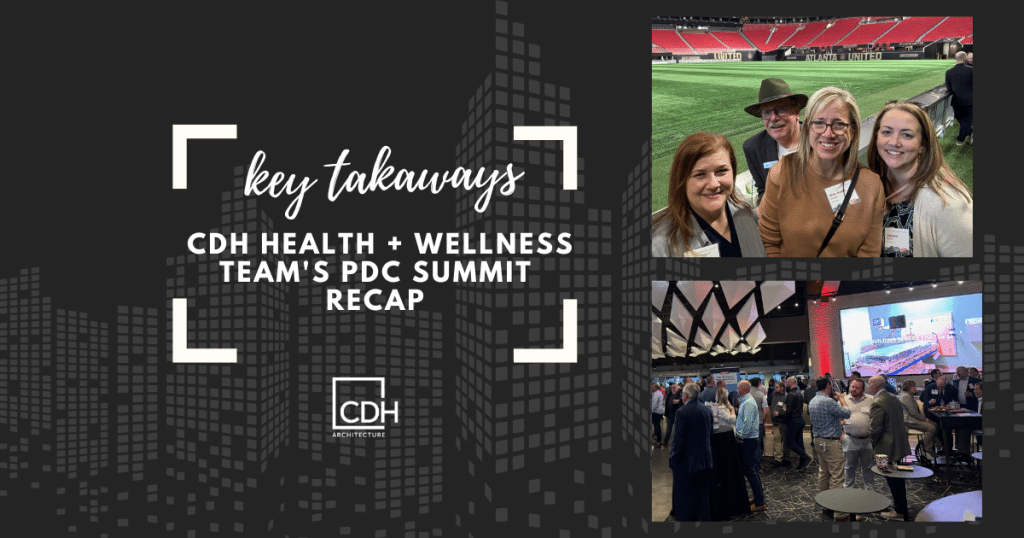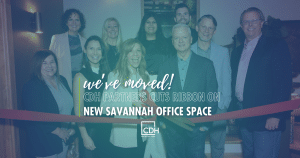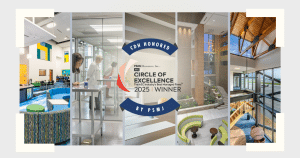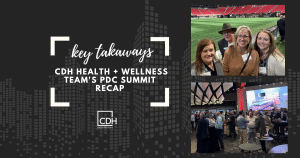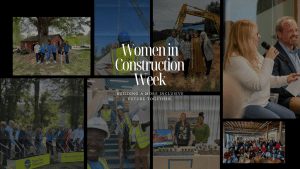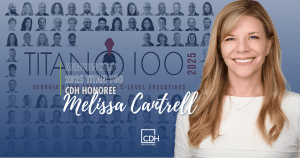The CDH Partners Health + Wellness team recently attended the ASHE PDC Summit in Atlanta, where we had the opportunity to earn CEUs, network with industry leaders, and immerse ourselves in the latest trends and best practices in healthcare design. The summit provided valuable insights across a range of critical topics, reinforcing many of our firm’s core values and highlighting new areas for growth and innovation. Here are our key takeaways:
The Importance of Collaboration
The summit emphasized the value of bringing together different stakeholders – including designers, healthcare providers, and solutions providers – to foster a deeper understanding and drive improvements in patient and staff outcomes. This collaborative approach is fundamental to successful healthcare projects.
Keynote speaker Morris Morrison encouraged attendees to embrace discomfort to catalyze change. He emphasized the role discomfort plays in growth and evolution to facilitate change.
Best Practices:
- Interdisciplinary Teams: Foster collaboration between architects, engineers, clinicians, patients, and facility managers from the project’s inception.
- Early Stakeholder Engagement: Involve all stakeholders in the planning and design phases to ensure their needs and perspectives are considered.
- Communication Protocols: Establish clear communication channels and protocols to facilitate effective information sharing and decision-making.
- Shared Decision-Making: Implement processes that allow for shared decision-making, ensuring that all voices are heard and valued.
- Use of Technology: Employ collaborative technologies like BIM to enhance communication, coordination, and visualization of the design.

CDH's take
"We've always believed that collaboration is key to successful healthcare design," says Rhea Jeanne Starnes, Senior Associate at CDH Partners. "The PDC Summit reinforced this, reminding us that the best outcomes are achieved when architects, engineers, clinicians, patients, and facility managers work together from the very beginning. True collaboration means that all voices are heard and valued."
Focus on Research, Design, and Outcomes
A significant portion of the conference was dedicated to exploring the latest research in healthcare design, with a focus on how design decisions impact patient experience, clinical outcomes, and staff well-being. This evidence-based approach aligns perfectly with our commitment to creating healing environments that truly make a difference.
Best Practices:
- Evidence-Based Design (EBD): Integrate research findings into the design process to create environments that promote healing, reduce stress, and improve outcomes.
- Post-Occupancy Evaluation (POE): Conduct POEs to assess the effectiveness of the design and inform future projects.
- Data Collection and Analysis: Collect and analyze data on patient outcomes, staff satisfaction, and facility performance to evaluate design choices.
- Continuous Learning: Stay informed about the latest research and best practices in healthcare design through conferences, publications, and professional development.
- Design for Specific Populations: Consider the unique needs of different patient populations (e.g., elderly, pediatric) based on research and guidelines.

CDH's take
Jamie Case, Principal at CDH Partners, notes, "It's inspiring to see the growing emphasis on evidence-based design. The summit provided valuable insights into how research can inform our design decisions, leading to improved patient outcomes and enhanced staff satisfaction. We are committed to using POEs to assess the effectiveness of our designs and inform future projects.”
Technology Integration
The summit addressed the increasing role of technology in healthcare, including the use of AI in design and construction, and the integration of technology to enhance the care experience for patients and staff. This highlights how architectural design must incorporate and adapt to evolving technologies. AI was a large topic of conversation and concurrent session devoted an example of Lee Health system in Florida told their journey to design the “lab of the future”. Using advanced technology to aid in the clinical process of getting lab results quickly to health providers so they can make diagnosis. They ended up consolidating their labs in a new central location which allowed them to integrate the latest technology of robotics and AI.
Best Practices:
- Flexible Infrastructure: Design spaces with adaptable infrastructure to accommodate future technological advancements. In addition to infrastructure, providing flexible physical space for these future technology components stage and function.
- Seamless Integration: Integrate technology into the design in a way that is user-friendly, efficient, and does not disrupt the healing environment.
- Telehealth Integration: Design spaces that support telehealth services, such as dedicated rooms and appropriate technology infrastructure.
- Smart Building Systems: Implement smart building systems to optimize energy efficiency, improve building performance, and enhance the patient and staff experience.
- Cybersecurity: Incorporate cybersecurity measures into the design to protect sensitive patient data and ensure the reliability of technology systems.

CDH's take
"Technology is rapidly transforming healthcare, and it's crucial that our designs are both adaptable and cutting-edge," says Bill Leggett, Principal at CDH Partners. "The summit showcased some exciting advancements, from AI-powered design tools to smart building systems that optimize energy efficiency and enhance the patient experience. As designers, we will need to understand how humans will interact with some of these technologies and how it will affect the patient experience and care. We recognize the importance of flexible infrastructure and seamless technology integration in all our projects."
Addressing Staffing Challenges
Recognizing the issue of nurse burnout, the conference included programs that explored how facility design can help mitigate these challenges and create supportive spaces for caregivers. This demonstrates the impact of architectural design on staff well-being and efficiency.
Best Practices:
- Ergonomic Design: Design workspaces that are ergonomic and support the physical well-being of staff, reducing fatigue and injury.
- Staff Respite Areas: Create dedicated spaces for staff to relax and recharge, promoting mental and emotional well-being.
- Efficient Workflow: Design layouts that optimize workflow and reduce unnecessary movement, improving staff efficiency.
- Natural Light and Views: Incorporate natural light and views of nature to improve staff mood and reduce stress.
- Decentralized Workstations: Consider decentralized workstations to improve staff visibility and reduce travel distances.

CDH's take
Danny Mackey, Associate Principal at CDH Partners, emphasizes, "Strategic space planning is critical for supporting healthcare staff. Aligning with the summit's focus on mitigating burnout, we design efficient, uplifting workspaces that prioritize staff wellbeing."
Diverse Healthcare Needs
The program considered the variety of population groups, with sessions focused on specific areas such as behavioral health facilities, design for dementia, and the unique needs of pediatric and adolescent patients. This highlights the need for architectural designs to cater to diverse and specialized needs.
Behavioral Health took another large track of sessions. One of the concurrent sessions had a panel of behavioral health experts in planning, design, and construction that talked about the emergence of emergency psychiatric assessment, treatment and healing (EmPATH) units. This was a timely session as CDH is working on an EmPATH unit for one of our clients.
Best Practices:
- Universal and Inclusive Design: Apply universal design principles to create spaces that are accessible and usable by people of all ages and abilities that can flex and adapt to changing needs of the facility.
- Culturally Sensitive Design: Consider the cultural needs and preferences of the community being served in the design.
- Specialized Design: Design specialized spaces that address the unique needs of specific patient populations (e.g., sensory rooms for children with autism, calming environments for behavioral health patients).

CDH's take
"Healthcare design is not one-size-fits-all," says Mary Lindeman, Principal at CDH Partners. "The summit's emphasis on diverse healthcare needs reinforces our commitment to inclusive and universal design principles. We strive to create spaces that are accessible, culturally sensitive, and tailored to the specific needs of each patient population, whether it's a child with autism or an elderly patient with dementia."
The PDC Summit provided us with invaluable knowledge and connections that will undoubtedly enhance our ability to serve our clients and create healing environments that make a positive impact. We are excited to incorporate these insights into our future projects and continue to push the boundaries of healthcare design. For more information about our healthcare projects, visit our portfolio page.


